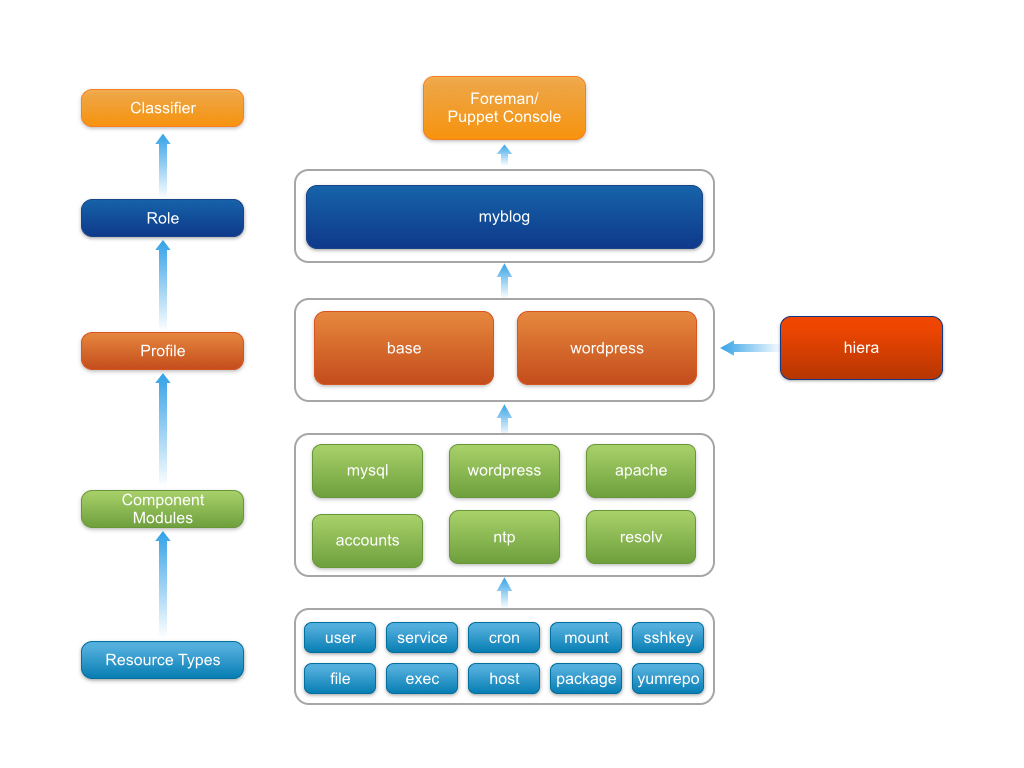Roles and Profiles Pattern (Methodology)¶
Overview¶
Provides a methodology for abstraction of Puppet code.
It's all about abstraction:
- Data (parameters) gets abstracted by Hiera
- Providers/Resources abstract the underlying OS implementation
- Providers get abstracted by Types
- Resources get abstracted by Classes
- Classes get abstracted by Modules (Component Modules)
- Modules get abstracted by Profiles
- Profiles get abstracted by Roles
Classification/Abstraction Flow:¶
- A node is assigned a Role
- A Role includes one or more Profiles
- Profiles include Component modules, Resources combined with logic.
- Make calls out to Hiera for hierarchal specific data (parameters)
- Hiera data is passed to Component modules
- Component modules call Puppet Resources
- Puppet Resources use Types/Providers to configure setting on a node

Profiles¶
Combines modules andresources to define a logical technology stack(single).
For more detail consult the documented set of guidelines
Profiles follow the following rules:
- Technology specific
- May include resources directly
- May make calls to Hiera for required data (parameters)
- These calls may be transparent via automatic parameter lookup
- Include Component module classes/resources
- Named according to the technology they manage
- Do NOT include environments in profile nawmes
Being technology specific does not limit the profile to managing a single application. It should include all applications and logic need to fully manage an application stack.
Example:
class profile::wordpress {
## Hiera lookups
$site_name = hiera('profiles::wordpress::site_name')
$wordpress_user_password = hiera('profiles::wordpress::wordpress_user_password')
$mysql_root_password = hiera('profiles::wordpress::mysql_root_password')
$wordpress_db_host = hiera('profiles::wordpress::wordpress_db_host')
$wordpress_db_name = hiera('profiles::wordpress::wordpress_db_name')
$wordpress_db_password = hiera('profiles::wordpress::wordpress_db_password')
$wordpress_user = hiera('profiles::wordpress::wordpress_user')
$wordpress_group = hiera('profiles::wordpress::wordpress_group')
$wordpress_docroot = hiera('profiles::wordpress::wordpress_docroot')
$wordpress_port = hiera('profiles::wordpress::wordpress_port')
## Create user
group { 'wordpress':
ensure => present,
name => $wordpress_group,
}
user { 'wordpress':
ensure => present,
gid => $wordpress_group,
password => $wordpress_user_password,
name => $wordpress_group,
home => $wordpress_docroot,
}
## Configure mysql
class { 'mysql::server':
root_password => $mysql_root_password,
}
class { 'mysql::bindings':
php_enable => true,
}
## Configure apache
include apache
include apache::mod::php
apache::vhost { $::fqdn:
port => $wordpress_port,
docroot => $wordpress_docroot,
}
## Configure wordpress
class { '::wordpress':
install_dir => $wordpress_docroot,
db_name => $wordpress_db_name,
db_host => $wordpress_db_host,
db_password => $wordpress_db_password,
}
}
Roles¶
A unquie collection (wrapper) of one or more profiles (technology stacks) to define a node
For more detail consult the documented set of guidelines
Roles follow the following rules:
- Maps technology to a node
- Nodes get classified with only a SINGLE role
- A role similar, yet different, from another role is: a NEW role.
- Do NOT include logic
- ONLY use includes for abstracting profiles
- Named according to the nodes purpose (business logic)
Example:
Includes the profile wordpress to install/configure wordpress and includes the base profile to configure globally common settings such as NTP and default user accounts.
class role::myblog {
include profile::wordpress
include profile::base
}
References¶
Puppet Camp 2013 Presentation Puppet Roles and Profiles Workflow (SH*% Gary Says)